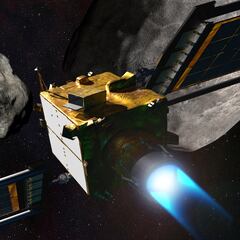Did NASA manage to divert an asteroid with the DART impact?
The groundbreaking mission aims to establish whether the space agency can influence the course of asteroids and prevent them hitting earth.


NASA’s DART spacecraft has successfully collided with the asteroid Dimorphos in the first stage of the agency’s test of its planetary defence capabilities.
DART, the Double Asteroid Redirection Test, saw a car-sized spacecraft guided into direct contact with Dimorphos. The team from NASA and Johns Hopkins University watched on as the craft streamed live footage of its approach to the asteroid.
The asteroid was around 6.8m miles from earth when DART scored “basically a bullseye” direct hit, according to deputy program manager Elena Adams.
“We knew we were going to hit. All of us were holding our breath. I’m kind of surprised none of us passed out,” she said. “I think, as far as we can tell, the first planetary defense test was a success, and we can clap to that.”
Impact! NASA's DART spacecraft has collided with asteroid Didymos, hitting at a velocity of more than 14,000 mph in a historic planetary defense experiment. https://t.co/OtCYO9fJyN pic.twitter.com/rlWiUycLt8
— Spaceflight Now (@SpaceflightNow) September 26, 2022
However while the team achieved the primary goal, researchers are not yet able to confirm whether the impact had any effect on the asteroid’s trajectory. The mission’s long-term goal is to prove that humanity is able to divert the course of a celestial being to prevent a collision with earth.
The DART team will need at least two months to monitor the asteroid’s change of speed and movement to calculate whether the impact changed course. But, for now at least, it appears that the program has been a success and it bodes well for hopes of planetary defence in future.
How will scientists know whether DART has been successful?
As the full name suggests, DART aims to study the consequences of an impact on a “double asteroid”. Dimorphos is traveling through the universe in tandem with the larger asteroid Didymos, and is actually orbiting it.
Scientists will actually be monitoring how the impact affected both celestial bodies, both individually and how they way in which they interact changes.
While everybody is arguing & fighting over all manner of terrestrial issues, @NASA’s Double Asteroid Redirect Mission (DART) slams a space probe into an asteroid’s moonlet today. Consider it practice, deflecting killer asteroids that might head our way.https://t.co/kfuyZZI76v
— Neil deGrasse Tyson (@neiltyson) September 26, 2022
Nancy Chabot, planetary scientist at Johns Hopkins’ University, explained: “We knew [one orbit] used to be 11 hours and 55 minutes. What is it going to be now? The telescopes are gonna measure that period of change, and they’re so good at this.”
Related stories
“They’ve done it for decades already to get us to that point, and they’re gonna work for the next weeks and make that measurement.”
The craft that struck the asteroid weighed just 1,260 pounds (570kg), so would only have had a fairly minor impact on the 11 billion-pound (5 billion kg) asteroid. However experts believe that it could alter its trajectory enough to knock around ten minutes of the asteroid’s previous orbit time.

